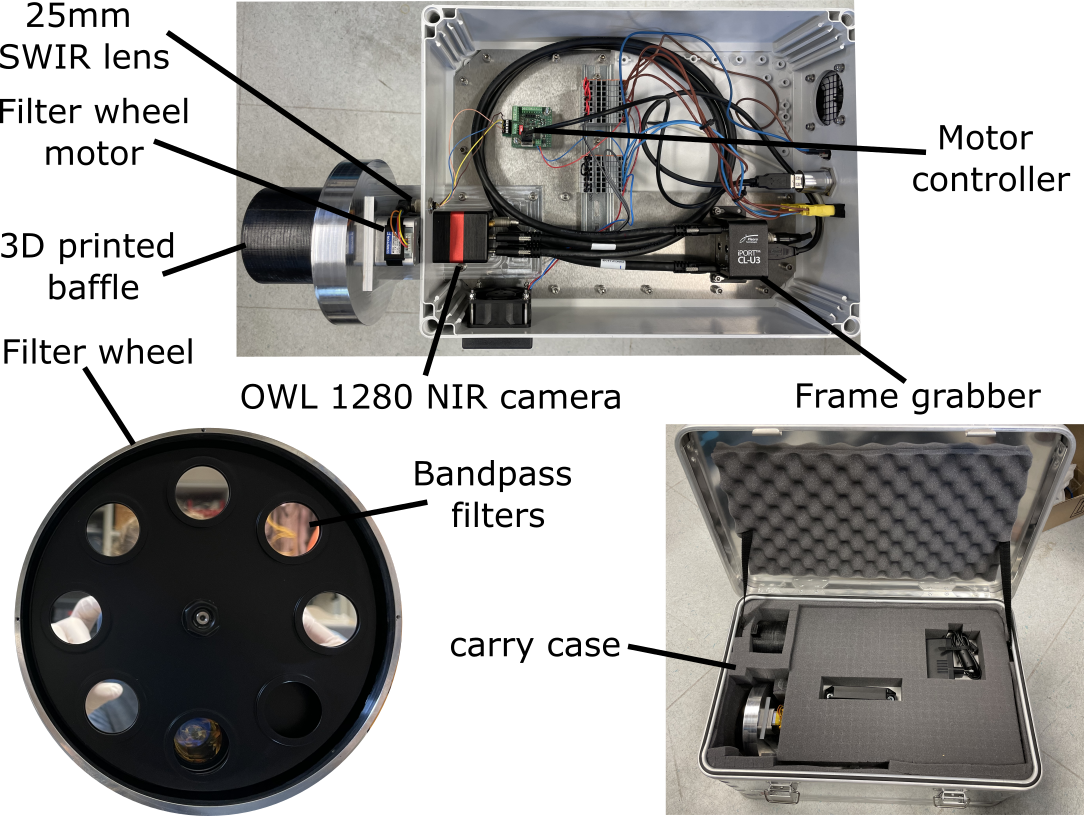The Venus Emissivity Mapper Emulator 2.0: a NIR camera system for Venus analogue field measurements
- 1Institute of Planetary Research, German Aerospace Center (DLR), Berlin, Germany, (stephen.garland@dlr.de)
- 2Jet Propulsion Laboratory, California Institute of Technology, CA, USA
- 3Freie Universität Berlin, Germany
- 4Institute of Earth and Environmental Science, Albert-Ludwigs-Universität Freiburg, Germany
- 5Lunar and Planetary Laboratory, University of Arizona, USA
- 6Institute of Optical Sensor Systems, German Aerospace Center (DLR), Berlin, Germany
Introduction
Both NASA’s VERITAS [1] and ESA’s EnVision missions to Venus incorporate a Venus Emissivity Mapper (VEM) [2,3] to characterise the surface and distinguish rock types and potentially their alteration states. Due to Venus’ visibly opaque atmosphere direct observations of the surface are challenging, however there are five atmospheric windows in the near infrared which will be exploited by the VEM instrument. In preparation for these missions and after successful preliminary work an improved emulator of the VEM instrument (VEMulator2.0) has been constructed for field measurements. The instrument was used in a two-week field campaign at Venus analogue sites in Iceland in August 2023, in the framework of the VERITAS expedition to Iceland [4,5], to collect reflectance measurements of volcanic rocks of varying age and surface conditions, as well as to measure emission from recently erupted lava with hot spots up to approximately 400 °C (see [6]). The goal of the work was to assess the capability of the VEM instrument to detect differences in surface composition with the limited spectral information provided by the 6 bands in a wide variety of realistic volcanic rock types. To achieve this, samples of the imaged regions were collected to be analysed in detail with the extensive spectroscopy facilities of the Planetary Spectroscopy Laboratory (PSL), DLR Berlin. By comparing the laboratory spectra with the field measurements insights into the effectivity and limitations of the instrument can be gained. This contribution will show the VEMulator design and calibration procedure as well as first results from field measurements in comparison with the those obtained in the laboratory. Details will be provided of the camera setup used in the field, the calibration of the camera and the application of the calibration to example data from the field.
The camera system
A top view of the camera system is shown in Figure 1. The system is based around a cooled NIR InGaAs OWL 1280 Camera from the company Raptor Photonics, sensitive in the range 0.6 to 1.7µm. A frame grabber (Pleora Technologies, iPort CL-U3) was used to read out images from the camera via a Camera Link interface. In front of this was positioned a filter wheel containing 6 commercially available 1” bandpass filters from Thorlabs with central wavelengths closely matching those chosen for VEM: 860nm, 910nm, 990nnm, 1030nm, 1100nm, 1200nm. Between the detector and the filter wheel a C-mount 25mm SWIR lens was fitted. The detector, frame grabber and motor controller unit were accommodated inside a dustproof casing with two fans for cooling of the camera housing, which requires heat dissipation due to the inbuilt TEC for detector cooling. The camera system can be mounted on a tripod and packed into a transport box.
Software was written in order to control the filter wheel and automatically acquire images for each filter. In addition, the camera settings can either be automatically or manually adjusted for each image set.

Figure 1 The VEMulator 2.0 camera system.
Camera calibration
A calibration of the camera has been undertaken using a calibrated integrating sphere with halogen lamp light sources. This produces a homogenous light field with known radiance at fixed distances, allowing raw camera data to be converted into radiances. By cycling through the exposure time and gain parameters of the camera system a set of calibration functions has been determined with which field data can be interpreted.
Laboratory measurements under Venus conditions
To verify the camera calibration and provide emission measurements under known conditions, the camera system was mounted on top of the Venus chamber [7] at the Planetary Spectroscopy Laboratory in Berlin. The chamber was used to inductively heat samples of the 2023 Fagradalsfjall eruption collected from the 2023 VERITAS field campaign to Iceland [5]. The samples were prepared in slab form as well as 1-2mm and 150-250µm grain sizes. Additionally, an approximator to a black body emitter, consisting of a graphite slab, was measured. The measurements were taken at temperatures from 150 to 450 °C, covering the range of temperatures observed from the freshly erupted lava observed during the field campaign.
Summary
An emulator of the VEM instrument has been constructed for field measurements and has been used during the VERITAS expedition to Iceland in 2023. The camera construction will be presented as well as the calibration of the camera using an integrating sphere with a halogen light source and a Venus chamber at the PSL in Berlin, used to image basalt samples at controlled temperatures. These procedures will be shown as well as their application to images collected from freshly erupted lava in order to acquire a 6-point emissivity spectrum.
Acknowledgments: Funding support was received from the European Union's Horizon 2020 research and innovation programme under grant agreement No 871149.
References
[1] Smrekar, S. (2022) IEEE Aerospace Conf. [2] Helbert, J., et al. (2022) SPIE. [3] Helbert, J. et al. (2024) LPSC 55. [4] Nunes, D. et al. (2023) LPSC 54. [5] Nunes, D. et al. (2024) LPSC 55. [6] Adeli, S. et al. (2024) EPSC 2024. [7] Helbert, J. et al. (2023) SPIE.
How to cite: Garland, S., Adeli, S., Nunes, D., Smrekar, S., Althaus, C., Müller, N., Domac, A., Alemanno, G., Barraud, O., Maturilli, A., Hamilton, C., Trauthan, F., Wendler, D., Hagelschuer, T., Demirok, R., Chauhan, S., Peter, G., and Helbert, J.: The Venus Emissivity Mapper Emulator 2.0: a NIR camera system for Venus analogue field measurements, Europlanet Science Congress 2024, Berlin, Germany, 8–13 Sep 2024, EPSC2024-890, https://doi.org/10.5194/epsc2024-890, 2024.